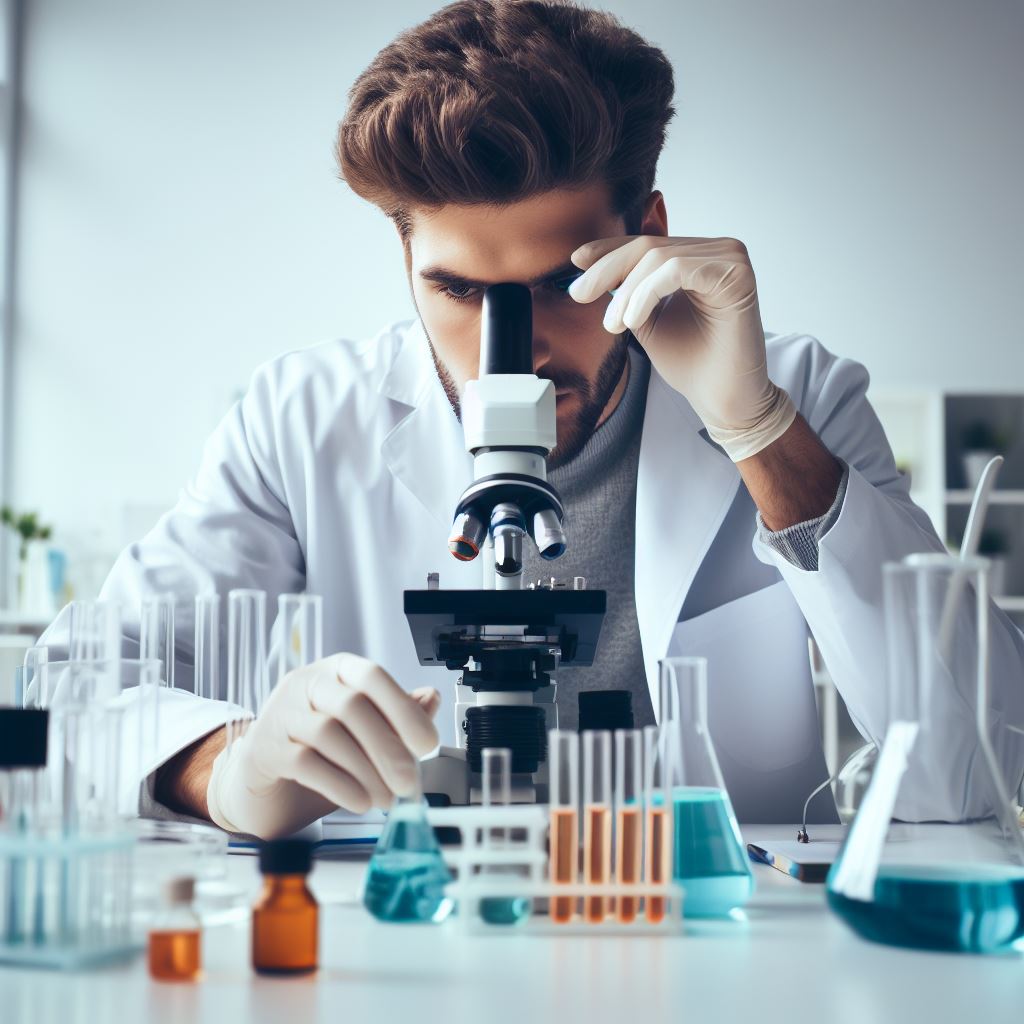Introduction
Conservation efforts are crucial in preserving the natural beauty and biodiversity of America. lets discuss biologists role in america Conservation efforts
These efforts aim to protect endangered species, restore habitats, and ensure the sustainability of ecosystems.
Biologists play a pivotal role in these conservation endeavors.
Importance of the role of biologists in conservation
Biologists bring their expertise and knowledge to the table, conducting research, studying wildlife populations, and monitoring ecological changes.
They assess the health of different habitats and identify areas that require immediate attention for conservation.
With their specialized training, biologists can identify threats to various species and propose measures to mitigate them.
They work closely with government agencies, NGOs, and local communities to develop and implement conservation plans that are scientifically sound and effective.
Significant role played by biologists in America’s conservation efforts
Biologists also play a crucial role in wildlife management, ensuring that populations remain balanced and healthy.
Through their research and data collection, scientists inform policies and regulations to protect and conserve species for future generations.
In addition to research and monitoring, biologists contribute to public education and awareness.
They host workshops, deliver presentations, and produce educational content to emphasize the significance of conservation and individuals’ role in preserving our natural heritage.
In review, biologists have a significant role in America’s conservation efforts.
Their expertise, research, and advocacy contribute to the preservation of ecosystems, protection of species, and maintenance of ecological balance.
The collaboration between biologists and other conservation stakeholders is crucial for achieving long-term conservation goals and ensuring a sustainable future for America’s natural resources.
Overview of Conservation Efforts in America
Conservation is the active management and protection of natural resources to prevent their depletion or destruction.
Definition and purpose of conservation
The purpose of conservation is to maintain a balance between human activities and the preservation of the environment.
In America, conservation efforts are crucial as the country is home to diverse ecosystems and wildlife habitats.
State of conservation in America
The state of conservation in America is a mixed bag, with both successes and challenges.
Successful conservation projects in America have contributed to the protection of endangered species and ecosystems.
One notable example is the preservation of the bald eagle population through the banning of DDT.
Another success story is the reintroduction of the gray wolf in Yellowstone National Park, which helped restore the park’s ecosystem.
Conservation efforts have also focused on preserving marine life, such as the establishment of marine protected areas.
The creation of national parks and wildlife refuges has been instrumental in safeguarding natural habitats.
Efforts to control invasive species, like the eradication of the brown tree snake in Guam, have proven effective.
Examples of successful conservation projects
However, despite these successes, conservation in America still faces numerous challenges. Loss of habitat due to urbanization and deforestation remains a significant threat to many species.
Climate change is also a pressing concern as it disrupts ecosystems and alters natural patterns. Poaching and illegal wildlife trade continue to harm endangered species, such as elephants and rhinos.
Native plants and animals are being displaced by invasive species, disrupting local ecosystems. Conservation efforts need to address the growing problem of pollution, especially in bodies of water.
To enhance America’s conservation efforts, collaboration between biologists and other stakeholders is crucial.
Biologists play a crucial role in conservation by studying species, monitoring habitats, and developing conservation strategies.
Transform Your Career Today
Unlock a personalized career strategy that drives real results. Get tailored advice and a roadmap designed just for you.
Start NowThey conduct research to understand the impacts of human activities on ecosystems and wildlife. Through their work, biologists can identify endangered species and develop plans for their protection.
Biologists also work on restoration projects, reclaiming lands damaged by human activities and reintroducing native species.
Education and outreach programs led by biologists help raise awareness about the importance of conservation.
Collaboration between biologists, government agencies, NGOs, and local communities is essential for successful conservation.
Funding is a critical factor in supporting conservation efforts, ensuring the necessary resources for research and implementation.
Public participation and support are also crucial in driving conservation initiatives forward. In addition, Basically, conservation efforts in America aim to protect and sustain the country’s invaluable natural resources.
Successful projects demonstrate the positive impact of conservation, while challenges highlight the need for continuous action.
Biologists, along with various stakeholders, contribute significantly to America’s conservation efforts through research, restoration, and education.
By working together, we can ensure the preservation of America’s rich biodiversity and natural heritage for future generations.
Read: Fields of Specialization: Niche Areas for Biologists in the US
The Role of Biologists in Conservation Efforts
Definition and role of biologists in conservation
Biologists are scientists who study living organisms and their interactions with the environment. In the context of conservation, they focus on understanding and preserving biodiversity.
They play a crucial role in America’s conservation efforts by studying and protecting the natural world.
Their role encompasses various activities, including conducting research and studies, designing and implementing conservation plans, and collaborating with other stakeholders.
Through their work, biologists contribute to the sustainable management and protection of wildlife populations and their habitats.
Conducting research and studies
One of the primary responsibilities of biologists in conservation is to collect and analyze data related to the various aspects of biodiversity. They study wildlife populations, their behavior, and their habitat requirements.
By gathering scientific evidence, biologists contribute to the understanding of ecosystem dynamics and the impacts of human activities on natural environments.
Furthermore, biologists monitor wildlife populations and habitats regularly. They observe and track changes in species abundance, distribution, and health.
This monitoring process helps identify trends and issues that require intervention to prevent biodiversity loss.
Designing and implementing conservation plans
Biologists also play a significant role in developing conservation plans. They assess the threats facing biodiversity, such as habitat destruction, pollution, invasive species, and climate change.
By understanding these threats, biologists can identify areas and species at risk and determine appropriate conservation strategies.
Based on their assessments, biologists develop comprehensive plans for habitat restoration, species recovery, and overall biodiversity conservation.
These plans may include creating protected areas, implementing breeding and reintroduction programs for endangered species, and promoting sustainable land use practices.
Collaborating with other stakeholders
Effective conservation efforts require collaboration between various stakeholders. Biologists work closely with government agencies, nonprofits, and local communities to achieve shared conservation goals.
By collaborating with government agencies, biologists contribute to policymaking processes and help shape conservation regulations.
They provide scientific expertise and data-driven recommendations to ensure that conservation efforts align with the best available knowledge.
Engaging local communities is equally crucial. Biologists raise awareness about the importance of biodiversity and the benefits of conservation.
They actively involve communities in conservation activities, encouraging participation in citizen science projects, habitat restoration efforts, and responsible eco-tourism.
By fostering a sense of stewardship and ownership, biologists empower communities to take an active role in protecting their natural heritage.
Showcase Your Business Today
Reach thousands of readers actively exploring professional services. Publish your business profile and grow your audience now.
Publish NowIn general, biologists play a fundamental role in America’s conservation efforts.
Through their research, assessment, and collaboration with stakeholders, they provide the necessary scientific foundation for biodiversity conservation.
Their work contributes to maintaining healthy ecosystems and ensuring the long-term survival of wildlife species and habitats.
It is crucial to recognize and support the invaluable contributions of biologists in preserving America’s natural heritage.
Read: Research Opportunities: Leading Biology Projects in America
Gain More Insights: Earning Potential: Chemist Salaries Across US States
Gain More Insights: Exploring Various Fields of Anthropology
Contributions of Biologists to America’s Conservation Efforts
Biologists in America have made significant contributions to the nation’s conservation efforts.
Through their research, expertise, and dedication, they have played a crucial role in preserving and protecting the environment and its biodiversity.
Preservation of endangered species
- Biologists conduct genetic research and breeding programs to protect endangered species.
- They also work on protecting habitats and implementing conservation measures to ensure the survival of these species.
One of the key areas where biologists have made a significant impact is in the preservation of endangered species.
By conducting genetic research and breeding programs, they aim to ensure the survival and genetic diversity of these species.
Biologists work closely with zoos, wildlife reserves, and conservation organizations to implement these programs effectively.
Restoration and conservation of ecosystems
- Biologists play a crucial role in rehabilitating degraded ecosystems by restoring vegetation and biodiversity.
- They implement sustainable practices for resource management to conserve ecosystems for future generations.
Additionally, biologists focus on protecting habitats and implementing conservation measures to create a conducive environment for endangered species.
They study the needs and requirements of these species, develop strategies to protect their habitats, and raise awareness about their importance and the threats they face.
Promoting biodiversity and ecological balance
- Biologists work towards preventing the spread of invasive species, which disrupt ecological balance.
- They also focus on restoring and maintaining natural habitats that support diverse species and ecosystems.
Another essential contribution of biologists is in the restoration and conservation of ecosystems. They play a vital role in rehabilitating degraded ecosystems, such as forests, wetlands, and coral reefs.
By restoring vegetation and biodiversity, they help create a balanced and healthy ecosystem.
Biologists also work towards implementing sustainable practices for resource management.
They develop strategies that ensure the efficient use of resources while minimizing the negative impact on the environment.
By promoting sustainable practices, they aim to conserve ecosystems and resources for future generations.
Furthermore, biologists actively promote biodiversity and ecological balance. They work towards preventing the spread of invasive species, which can significantly disrupt ecosystems.
By identifying and controlling invasive species, they help maintain the natural balance and diversity of ecosystems.
Biologists also focus on restoring and maintaining natural habitats that support diverse species. They study the specific needs of different species and work towards creating favorable conditions for their survival.
By protecting and restoring these habitats, biologists contribute to the overall biodiversity and ecological balance of America’s ecosystems.
Ultimately, biologists in America play a critical role in conservation efforts. Their contributions in preserving endangered species, restoring ecosystems, and promoting biodiversity are invaluable.
Through their research and conservation measures, they strive to protect the environment and ensure its sustainability for future generations.
The work of biologists is essential in maintaining the delicate balance of ecosystems and conserving the rich biodiversity of America.
Read: Challenges & Rewards: The Realities of Being a Biologist in the US

Uncover the Details: Zoologist vs. Veterinarian: Comparing Career Paths
Uncover the Details: How to Secure Funding for Botanical Research Projects
Challenges and Future Perspectives for Biologists in Conservation
Biologists engaged in conservation efforts face a range of challenges that affect both their research endeavors and the overall success of conservation initiatives in the United States.
These challenges require innovative solutions and a forward-thinking approach to ensure the preservation of biodiversity and the integrity of ecosystems.
Current challenges faced by biologists in conservation efforts
Climate change and its impact on biodiversity
One of the most significant challenges faced by biologists is the rapidly changing climate and its detrimental effects on biodiversity.
Rising temperatures, altered precipitation patterns, and increased frequency of extreme weather events all contribute to habitat loss and species decline.
Biologists must explore strategies to mitigate these impacts and protect vulnerable ecosystems.
Limited funding and resources
Conservation efforts often face limited funding and resources, making it difficult for biologists to conduct necessary research and implement conservation measures effectively.
Inadequate funding hampers the ability to monitor species, protect habitats, and engage in public outreach and education.
Collaboration with policymakers, NGOs, and communities is crucial to secure increased financial support for conservation initiatives.
Technological advancements and tools for conservation biologists
Remote sensing and GIS applications.
Technological advancements have opened up new opportunities for biologists to assess and monitor ecosystems from a distance.
Remote sensing techniques, such as satellite imagery and aerial surveys, allow for the detection of changes in land cover, habitat fragmentation, and conservation hotspots.
Geographic Information Systems (GIS) enable researchers to analyze spatial data and improve conservation planning and management strategies.
Molecular techniques for studying ecosystems
Molecular techniques, including DNA sequencing and isotopic analysis, have revolutionized the field of ecology and conservation biology.
By studying genetic diversity and population dynamics, biologists can gain valuable insights into the health of ecosystems.
These techniques also aid in the identification of endangered species, genetic markers for conservation, and the detection of invasive species.
Importance of continued research and education for biologists
Developing new conservation strategies
Biologists must engage in continued research to develop innovative conservation strategies.
This involves studying species-specific responses to environmental changes, identifying new mitigation techniques, and assessing the long-term effectiveness of conservation measures.
Collaboration between academia, research institutions, and conservation organizations fosters knowledge exchange and leads to science-based conservation practices.
Enhancing public engagement and advocacy
Biologists play a crucial role in educating the public about the importance of conservation efforts and advocating for policy changes.
By effectively communicating their research findings, they can raise awareness about environmental issues, inspire public action, and promote sustainable practices.
Public engagement and advocacy platform can help mobilize support and secure necessary resources for conservation initiatives.
To summarize, biologists face various challenges while carrying out conservation efforts in the United States.
Climate change impacts biodiversity significantly, and limited funding restricts the scope of research and conservation measures.
However, technological advancements such as remote sensing and molecular techniques provide valuable tools for biologists.
Continued research and education are essential to develop effective conservation strategies and enhance public engagement and advocacy.
Overcoming these challenges and adopting a proactive approach will contribute to the long-term preservation of America’s diverse ecosystems.
Read: Day in the Life: Routine Tasks for a US-Based Biologist
Gain More Insights: The Green Movement’s Impact on Environmental Science Careers
You Might Also Like: Innovative Technologies in Space Science Research
Conclusion
Biologists in America play a pivotal role in our conservation efforts. They actively research, monitor, and protect our diverse ecosystems, ensuring that our natural heritage thrives.
Their dedication to understanding and preserving the intricate web of life is invaluable.
Their contributions extend beyond research. By actively engaging in habitat restoration, conservation planning, and species reintroduction, biologists are the unsung heroes preserving our nation’s biodiversity.
Their work not only prevents the extinction of endangered species but also helps maintain ecological balance, benefiting all life forms.
As individuals, it’s crucial to support and appreciate the tireless work of these dedicated professionals.
By understanding and valuing the role of biologists, we can contribute to the broader conservation efforts.
Whether it’s through advocacy, volunteering, or simply spreading awareness, let’s rally behind these scientists and ensure a sustainable future for our planet.
[E-Books for Sale]
The Big Book of 500 High-Paying Jobs in America: Unlock Your Earning Potential
$19.99 • 500 High-Paying Jobs • 330 pages
Explore 500 high-paying jobs in America and learn how to boost your career, earn more, and achieve success!
See All 500 High-Paying Jobs of this E-Book
1001 Professions Without a Degree: High-Paying American Jobs You Can Start Now
$19.99 • 1001 Professions Without a Degree • 174 pages
Discover 1001 high-paying jobs without a degree! Unlock career tips, skills, and success strategies for just $19.99!




